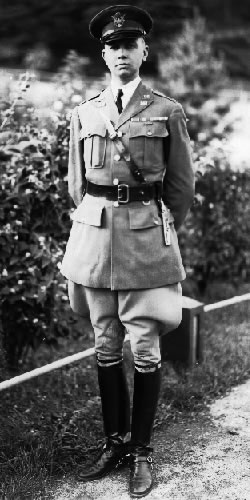Frederick Erastus Humphreys (September 16, 1883 – January 20, 1941) was one of the original three military pilots trained by the Wright brothers and the first to fly solo.
Frederick was born in 1883 in Summit, New Jersey, the only child of Jay Humphreys and Fannie Brush. He attended the Pennsylvania Military Academy, and won an appointment from New York to the United States Military Academy at West Point, New York. He was made Cadet Captain, he lettered in fencing, and was the top eighth student of seventy-eight in the West Point Class of 1906.
After graduation and commissioning, he was assigned to the Army Corps of Engineers and sent to Fort Riley, Kansas where he worked in bridge construction, he was deployed to Cuba during the Pacification Expedition, and a year later, returned to attend the Engineer Officer Basic Course. He joined the Army Signal Corps and became the first military pilot trained by the Wright brothers.
In 1910, Humphreys resigned his commission to attend to his father’s business, the Humphreys Homeopathic Medicine Company, founded by his grandfather in 1853. Thereafter he served as an officer of the company, the last twelve years of his life as its president.
National Guard
In June of 1915, Humphreys joined the New York National Guard’s 22d Engineers Regiment as a First Lieutenant. He was called up with his regiment for Mexican Border service after Pancho Villa’s raids in 1916, he served as an aide to Major General John F. O’Ryan, Commanding General of the New York (later 27th) Division.
Shortly after his return to New York, the regiment was inducted into federal service for World War I. After initial service with his regiment at the divisional training post at Spartanburg, South Carolina, he was recalled and was transferred to the Army Air Service in January of 1918.
After flight training at Rockwell Field in San Diego, California he was assigned to the first class of the School of Military Aeronautics at the Massachusetts Institute of Technology for advanced technical training. After his graduation, he was retained as head of the Department of Practical Aircraft Design, and then made school commander. At about the time of the Armistice, he was assigned to the newly founded Technical Section, Engineering Division, at McCook Field, in Dayton, Ohio, remaining there until he was demobilized in February of 1919. He went to New York, and was appointed Colonel of the 102d Engineers, a position he had until his retirement due to ill health on July 11, 1939. At the time he was the senior Colonel of New York. He was advanced to Brigadier General on the State Retired List.
Recuperating from pneumonia in Miami Beach, Florida he had a heart attack and died in 1941. He was 57 years old, and was buried in Arlington National Cemetery.
Shortly after 8 am on October 26, 1909, a mechanic held a gasoline soaked rag over the engine intake while another cranked the engine into life. Wilbur Wright hurriedly ran to a nearby shed for windowsash weights to replace his weight in the passenger seat. After a little over three hours of actual flying time, Lieutenant Humphreys became the first military student pilot to be told he was ready to “take her up on your own.” A catapult weight dropped, and plane and pilot were assisted aloft for a three minute flight.
Two more flights were made by Lieutenant Humphreys that day, the next of eight and one half minutes, and the last of twenty-four minutes. Lieutenant Lahm also soloed for three flights, and Wilbur Wright pronounced both “certified pilots.” Over the next few days the two flew practice flights together and separately, until November 5th, when they crashed the plane and American military aviation came to an abrupt and temporary end.
HUMPHREYS, FREDERICK E
- MAJOR AVIATION SECTION, SIGNAL CORP, USA
- DATE OF DEATH: 01/20/1941
- BURIED AT: SECTION SOUTH SITE 8937
ARLINGTON NATIONAL CEMETERY
Michael Robert Patterson was born in Arlington and is the son of a former officer of the US Army. So it was no wonder that sooner or later his interests drew him to American history and especially to American military history. Many of his articles can be found on renowned portals like the New York Times, Washingtonpost or Wikipedia.
Reviewed by: Michael Howard

